The “Your Windows Computer is Infected” pop-up is a misleading advertising that created in order to trick you into downloading an questionable software or calling to the fake Microsoft Support Service. Are you seeing Your Windows Computer is Infected With (4) Viruses! pop-up in the Chrome, Internet Explorer, FF and MS Edge every time you use the browser to surf the Internet? This means that an undesired software from the adware (sometimes named ‘ad-supported’ software) family get installed on your system. The ‘ad supported’ software looks the entire traffic generated by you and on this basis, it displays a large amount of unwanted ads, pop-ups and deals. Currently, this adware are widely spread, due to the fact that most people are trying to find freeware, download and install them on the computer without proper attention to the fact that the ad supported software can be installed onto the computer along with them.
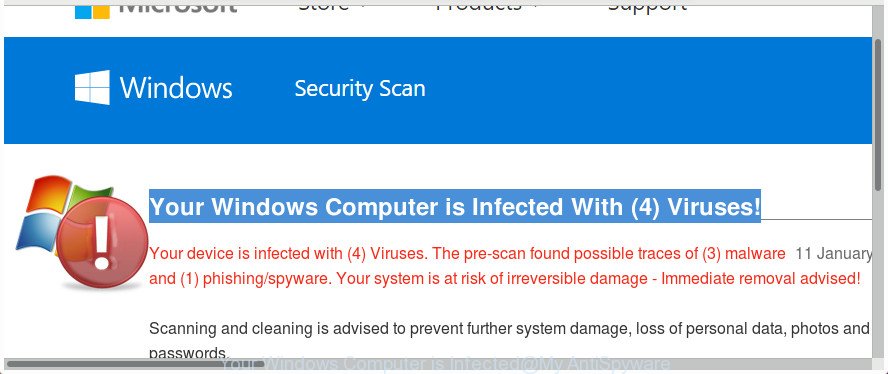
The “Your Windows Computer is Infected” is a misleading advertising
The full text of the misleading advertising is:
Your Windows Computer is Infected With (4) Viruses! Your device is infected with (4) Viruses. The pre-scan found possible traces of (3) malware and (1) phishing/spyware. Your system is at risk of irreversible damage - Immediate removal advised! Scanning and cleaning is advised to prevent further system damage, loss of personal data, photos and passwords. Traces of (1) Phishing/Spyware has been found on your computer. Personal and banking information may at risk.
What is more, the ‘ad supported’ software that displays misleading “Your Windows Computer is Infected” pop up on your computer, may open advertisements depend on a web site that you are visiting. That is, it’s clear that this adware, without your permission, steals your privacy info such as: your ip address, what is a web-page you are viewing now, what you are looking for on the Internet, which links you are clicking, and much, much more. Even worse, the adware may monetize its functionality by gathering privacy data from your surfing sessions. This user data, later, can be easily transferred to third parties. This puts your user information at a security risk.
In addition to that, as was mentioned earlier, certain ad supported software to also change all web-browsers shortcut files that located on your Desktop or Start menu. So, every infected shortcut will try to redirect your browser to annoying ad web-pages such as “Your Windows Computer is Infected”, certain of which might be malicious. It can make the whole PC more vulnerable to hacker attacks.
Instructions that is shown below, will allow you to clean your personal computer from the ad supported software as well as remove “Your Windows Computer is Infected” annoying pop-up advertisements from the Chrome, FF, Microsoft Internet Explorer and MS Edge and other internet browsers.
How to remove “Your Windows Computer is Infected” pop-up scam
Fortunately, it is not hard to remove adware which displays misleading “Your Windows Computer is Infected” pop-up on your machine. In the following guidance, we will provide two methods to free your computer of this ad-supported software. One is the manual removal method and the other is automatic removal method. You can select the method that best fits you. Please follow the removal tutorial below to get rid of “Your Windows Computer is Infected” fake alerts right now!
To remove “Your Windows Computer is Infected”, perform the following steps:
- How to manually remove “Your Windows Computer is Infected”
- Remove questionable programs using Microsoft Windows Control Panel
- Fix infected web-browsers shortcuts to remove “Your Windows Computer is Infected” redirect
- Remove unwanted Scheduled Tasks
- Remove “Your Windows Computer is Infected” fake alerts from Chrome
- Get rid of “Your Windows Computer is Infected” pop-up warnings from Firefox
- Remove “Your Windows Computer is Infected” fake alerts from Internet Explorer
- How to remove “Your Windows Computer is Infected” pop-up with free applications
- How to block “Your Windows Computer is Infected” pop up scam
- Where the “Your Windows Computer is Infected” pop up comes from
- Finish words
How to manually remove “Your Windows Computer is Infected”
The step-by-step instructions will help you delete “Your Windows Computer is Infected” pop-up warnings. These “Your Windows Computer is Infected” removal steps work for the Firefox, Microsoft Edge, Google Chrome and Microsoft Internet Explorer, as well as every version of Windows operating system.
Remove questionable programs using Microsoft Windows Control Panel
Check out the MS Windows Control Panel (Programs and Features section) to see all installed software. We advise to click on the “Date Installed” in order to sort the list of apps by the date you installed them. If you see any unknown and dubious programs, they are the ones you need to delete.
Windows 8, 8.1, 10
First, click the Windows button
Windows XP, Vista, 7
First, click “Start” and select “Control Panel”.
It will display the Windows Control Panel as displayed in the figure below.

Next, click “Uninstall a program” ![]()
It will open a list of all applications installed on your PC. Scroll through the all list, and delete any suspicious and unknown programs. To quickly find the latest installed software, we recommend sort apps by date in the Control panel.
Fix infected web-browsers shortcuts to remove “Your Windows Computer is Infected” redirect
Unfortunately, the ad supported software which shows misleading “Your Windows Computer is Infected” fake alerts on your PC, can also hijack Windows shortcuts (mostly, your web browsers shortcut files), so that the “Your Windows Computer is Infected” ad web site will be displayed when you run the Firefox, Internet Explorer, Microsoft Edge and Chrome or another web browser.
Right click on the shortcut of affected internet browser like below.
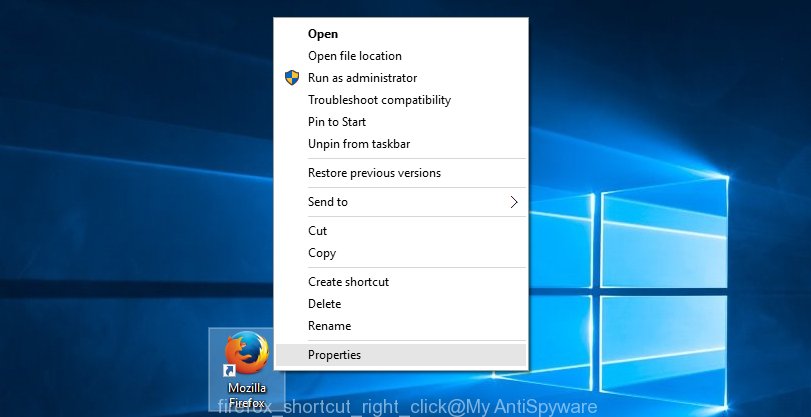
Select the “Properties” option and it will display the shortcut’s properties. Next, click the “Shortcut” tab and then delete the “http://site.address” string from Target field as displayed on the image below.
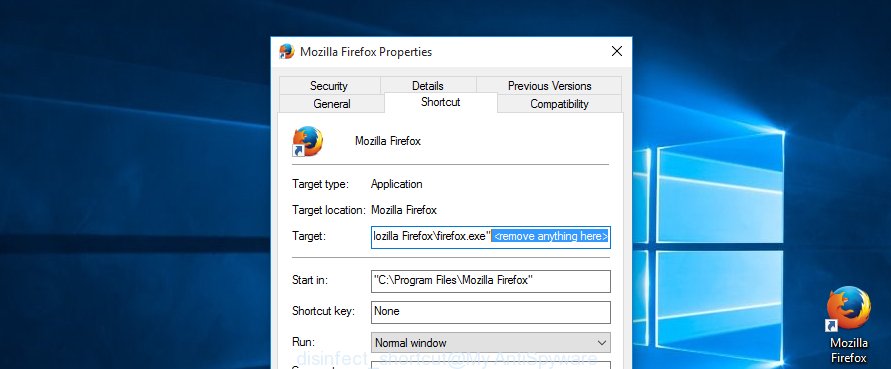
Then click OK to save changes. Repeat the step for all web-browsers which are rerouted to the “Your Windows Computer is Infected” intrusive web-page.
Remove unwanted Scheduled Tasks
If the undesired “Your Windows Computer is Infected” web-page opens automatically on Windows startup or at equal time intervals, then you need to check the Task Scheduler Library and remove all the tasks that have been created by malicious software.
Press Windows and R keys on the keyboard simultaneously. This displays a prompt that titled with Run. In the text field, type “taskschd.msc” (without the quotes) and click OK. Task Scheduler window opens. In the left-hand side, press “Task Scheduler Library”, as displayed below.
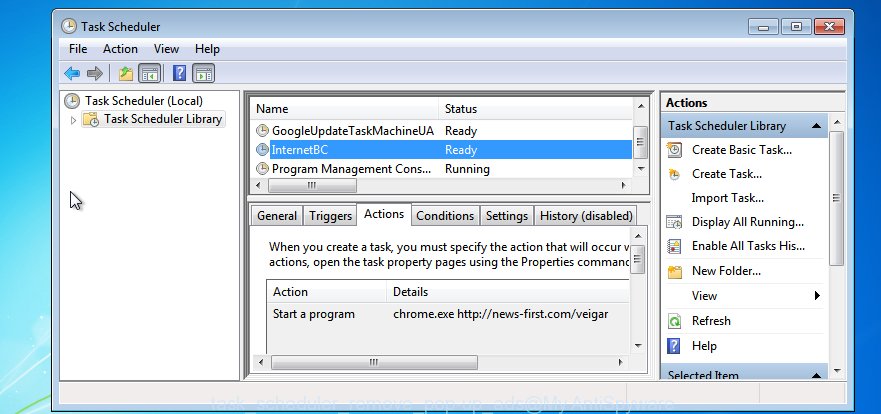
Task scheduler
In the middle part you will see a list of installed tasks. Please select the first task, its properties will be display just below automatically. Next, click the Actions tab. Pay attention to that it launches on your machine. Found something like “explorer.exe http://site.address” or “chrome.exe http://site.address”, then delete this harmful task. If you are not sure that executes the task, check it through a search engine. If it is a component of the ‘ad-supported’ program, then this task also should be removed.
Having defined the task that you want to remove, then press on it with the right mouse button and select Delete as displayed below.

Delete a task
Repeat this step, if you have found a few tasks that have been created by unwanted applications. Once is complete, close the Task Scheduler window.
Remove “Your Windows Computer is Infected” fake alerts from Chrome
If your Google Chrome browser is re-directed to intrusive “Your Windows Computer is Infected” web-page, it may be necessary to completely reset your web browser program to its default settings.

- First start the Chrome and click Menu button (small button in the form of three dots).
- It will display the Chrome main menu. Choose More Tools, then click Extensions.
- You will see the list of installed plugins. If the list has the add-on labeled with “Installed by enterprise policy” or “Installed by your administrator”, then complete the following guide: Remove Chrome extensions installed by enterprise policy.
- Now open the Google Chrome menu once again, press the “Settings” menu.
- You will see the Google Chrome’s settings page. Scroll down and click “Advanced” link.
- Scroll down again and press the “Reset” button.
- The Chrome will show the reset profile settings page as shown on the image above.
- Next click the “Reset” button.
- Once this procedure is complete, your web browser’s homepage, search provider and newtab page will be restored to their original defaults.
- To learn more, read the blog post How to reset Google Chrome settings to default.
Get rid of “Your Windows Computer is Infected” pop-up warnings from Firefox
Resetting your Mozilla Firefox is good initial troubleshooting step for any issues with your internet browser program, including the redirect to “Your Windows Computer is Infected” page.
Press the Menu button (looks like three horizontal lines), and click the blue Help icon located at the bottom of the drop down menu as shown below.

A small menu will appear, click the “Troubleshooting Information”. On this page, press “Refresh Firefox” button as on the image below.

Follow the onscreen procedure to revert back your Firefox web browser settings to its original state.
Remove “Your Windows Computer is Infected” fake alerts from Internet Explorer
By resetting IE internet browser you revert back your browser settings to its default state. This is first when troubleshooting problems that might have been caused by ‘ad supported’ software which cause misleading “Your Windows Computer is Infected” popup warnings to appear.
First, open the Microsoft Internet Explorer. Next, press the button in the form of gear (![]() ). It will display the Tools drop-down menu, press the “Internet Options” as displayed below.
). It will display the Tools drop-down menu, press the “Internet Options” as displayed below.

In the “Internet Options” window click on the Advanced tab, then click the Reset button. The Microsoft Internet Explorer will open the “Reset Internet Explorer settings” window as shown below. Select the “Delete personal settings” check box, then click “Reset” button.

You will now need to reboot your system for the changes to take effect.
How to remove “Your Windows Computer is Infected” pop-up with free applications
There are not many good free antimalware programs with high detection ratio. The effectiveness of malicious software removal tools depends on various factors, mostly on how often their virus/malware signatures DB are updated in order to effectively detect modern malware, adware, browser hijacker infections and other PUPs. We advise to use several programs, not just one. These programs which listed below will allow you remove all components of the ‘ad supported’ software from your disk and Windows registry and thereby get rid of “Your Windows Computer is Infected” pop up warnings.
How to automatically get rid of “Your Windows Computer is Infected” fake alerts with Zemana Anti-malware
You can remove “Your Windows Computer is Infected” popup automatically with a help of Zemana Anti-malware. We recommend this malicious software removal tool because it may easily delete hijackers, potentially unwanted apps, ad supported software that reroutes your browser to “Your Windows Computer is Infected” web-site with all their components such as folders, files and registry entries.
Now you can setup and use Zemana AntiMalware to remove “Your Windows Computer is Infected” pop-up scam from your web browser by following the steps below:
Click the following link to download Zemana Anti-Malware (ZAM) installer named Zemana.AntiMalware.Setup on your PC. Save it to your Desktop so that you can access the file easily.
164524 downloads
Author: Zemana Ltd
Category: Security tools
Update: July 16, 2019
Launch the setup package after it has been downloaded successfully and then follow the prompts to install this utility on your system.

During setup you can change some settings, but we suggest you do not make any changes to default settings.
When setup is finished, this malicious software removal tool will automatically start and update itself. You will see its main window as shown on the screen below.

Now click the “Scan” button to perform a system scan for the adware that designed to show misleading “Your Windows Computer is Infected” popup within your web browser. This task can take quite a while, so please be patient. While the Zemana Free tool is scanning, you may see number of objects it has identified as being infected by malicious software.

When the system scan is finished, Zemana will open a scan report. Review the report and then click “Next” button.

The Zemana Anti Malware will begin to remove adware which developed to show misleading “Your Windows Computer is Infected” pop-up within your web browser. Once that process is finished, you can be prompted to restart your PC to make the change take effect.
Remove “Your Windows Computer is Infected” pop up scam and harmful extensions with Hitman Pro
HitmanPro is a free removal utility which can scan your computer for a wide range of security threats such as malicious software, adwares, potentially unwanted programs as well as adware which causes misleading “Your Windows Computer is Infected” popup on your web-browser. It will perform a deep scan of your PC system including hard drives and Windows registry. When a malware is found, it will help you to delete all found threats from your computer with a simple click.
Visit the following page to download HitmanPro. Save it to your Desktop.
Download and run Hitman Pro on your PC system. Once started, click “Next” button to perform a system scan for the adware which cause misleading “Your Windows Computer is Infected” pop up to appear. A system scan can take anywhere from 5 to 30 minutes, depending on your system. During the scan Hitman Pro will scan for threats present on your PC system..
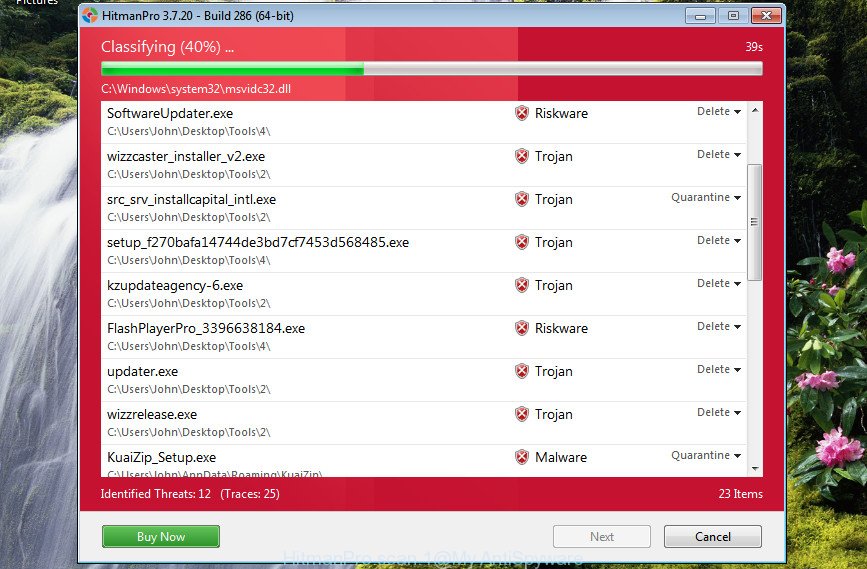
Once that process is finished, a list of all threats found is prepared.
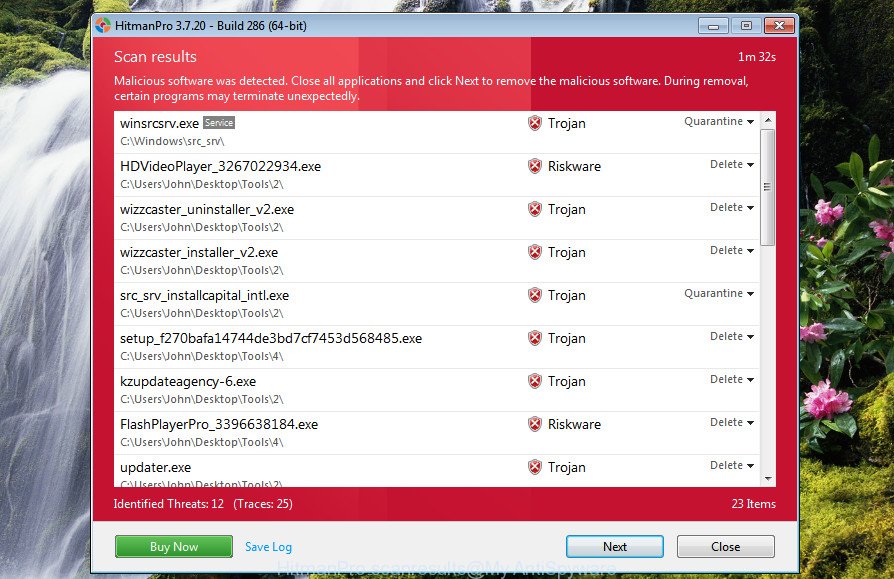
Review the report and then click Next button.
It will show a prompt, click the “Activate free license” button to begin the free 30 days trial to remove all malware found.
Automatically remove “Your Windows Computer is Infected” fake alerts with Malwarebytes
We suggest using the Malwarebytes Free. You can download and install Malwarebytes to search for ad supported software and thereby delete “Your Windows Computer is Infected” pop up warnings from your browsers. When installed and updated, the free malicious software remover will automatically check and detect all threats present on the machine.
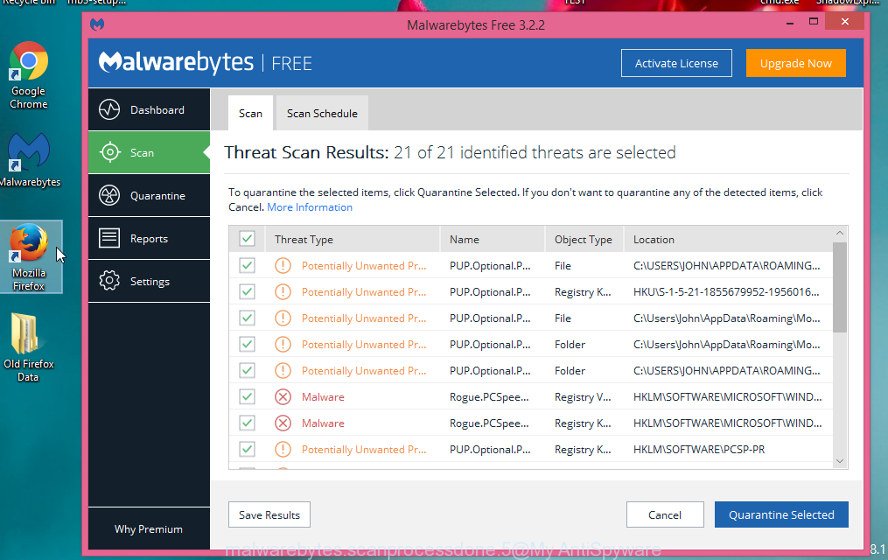
Download MalwareBytes Free by clicking on the link below. Save it to your Desktop so that you can access the file easily.
326872 downloads
Author: Malwarebytes
Category: Security tools
Update: April 15, 2020
Once the download is finished, run it and follow the prompts. Once installed, the MalwareBytes will try to update itself and when this procedure is finished, press the “Scan Now” button . MalwareBytes Free utility will start scanning the whole computer to find out adware which causes misleading “Your Windows Computer is Infected” pop-up scam on your internet browser. Depending on your system, the scan can take anywhere from a few minutes to close to an hour. When a malware, ad supported software or PUPs are detected, the count of the security threats will change accordingly. Wait until the the checking is finished. All detected items will be marked. You can delete them all by simply press “Quarantine Selected” button.
The MalwareBytes Anti Malware (MBAM) is a free application that you can use to delete all detected folders, files, services, registry entries and so on. To learn more about this malicious software removal utility, we recommend you to read and follow the few simple steps or the video guide below.
How to block “Your Windows Computer is Infected” pop up scam
Use an ad-blocker utility like AdGuard will protect you from malicious ads and content. Moreover, you can find that the AdGuard have an option to protect your privacy and block phishing and spam web sites. Additionally, ad-blocker apps will help you to avoid undesired pop up advertisements and unverified links that also a good way to stay safe online.
Installing the AdGuard is simple. First you will need to download AdGuard by clicking on the link below. Save it on your Desktop.
26786 downloads
Version: 6.4
Author: © Adguard
Category: Security tools
Update: November 15, 2018
After the download is finished, start the downloaded file. You will see the “Setup Wizard” screen as on the image below.

Follow the prompts. When the setup is complete, you will see a window as shown on the image below.

You can press “Skip” to close the installation application and use the default settings, or click “Get Started” button to see an quick tutorial that will assist you get to know AdGuard better.
In most cases, the default settings are enough and you don’t need to change anything. Each time, when you start your computer, AdGuard will start automatically and stop pop up advertisements, “Your Windows Computer is Infected” redirect, as well as other malicious or misleading sites. For an overview of all the features of the program, or to change its settings you can simply double-click on the AdGuard icon, which is located on your desktop.
Where the “Your Windows Computer is Infected” pop up comes from
The adware usually spreads as a part of various free software. In many cases, it may be bundled within the installers from Softonic, Cnet, Soft32, Brothersoft or other similar web sites. So, you should run any files downloaded from the Web with great caution, read the User agreement, Software license and Terms of use. In the process of installing a new program, you should select a Manual, Advanced or Custom setup option to control what components and optional software to be installed, otherwise you run the risk of infecting your computer with an adware that causes multiple misleading “Your Windows Computer is Infected” alerts and pop ups.
Finish words
Once you have complete the few simple steps above, your system should be clean from this adware and other malicious software. The Internet Explorer, Mozilla Firefox, Chrome and Edge will no longer open undesired “Your Windows Computer is Infected” web-site when you browse the Net. Unfortunately, if the step by step guide does not help you, then you have caught a new adware, and then the best way – ask for help.
Please start a new thread by using the “New Topic” button in the Spyware Removal forum. When posting your HJT log, try to give us some details about your problems, so we can try to help you more accurately. Wait for one of our trained “Security Team” or Site Administrator to provide you with knowledgeable assistance tailored to your problem with the annoying “Your Windows Computer is Infected” popup scam.



















